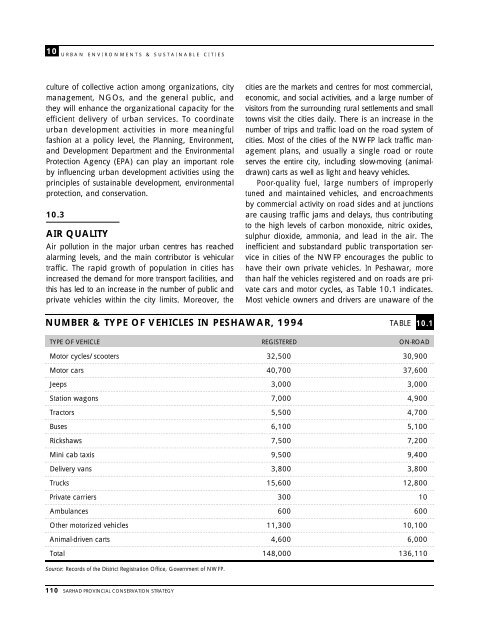Sarhad Provincial Conservation Strategy - IUCN
Sarhad Provincial Conservation Strategy - IUCN
Sarhad Provincial Conservation Strategy - IUCN
Create successful ePaper yourself
Turn your PDF publications into a flip-book with our unique Google optimized e-Paper software.
10<br />
U R B A N E N V I R O N M E N T S & S U S T A I N A B L E C I T I E S<br />
culture of collective action among organizations, city<br />
management, NGOs, and the general public, and<br />
they will enhance the organizational capacity for the<br />
efficient delivery of urban services. To coordinate<br />
urban development activities in more meaningful<br />
fashion at a policy level, the Planning, Environment,<br />
and Development Department and the Environmental<br />
Protection Agency (EPA) can play an important role<br />
by influencing urban development activities using the<br />
principles of sustainable development, environmental<br />
protection, and conservation.<br />
1 0 . 3<br />
AIR QUALITY<br />
Air pollution in the major urban centres has reached<br />
alarming levels, and the main contributor is vehicular<br />
traffic. The rapid growth of population in cities has<br />
increased the demand for more transport facilities, and<br />
this has led to an increase in the number of public and<br />
private vehicles within the city limits. Moreover, the<br />
110 SARHAD PROVINCIAL CONSERVATION STRATEGY<br />
cities are the markets and centres for most commercial,<br />
economic, and social activities, and a large number of<br />
visitors from the surrounding rural settlements and small<br />
towns visit the cities daily. There is an increase in the<br />
number of trips and traffic load on the road system of<br />
cities. Most of the cities of the NWFP lack traffic management<br />
plans, and usually a single road or route<br />
serves the entire city, including slow-moving (animaldrawn)<br />
carts as well as light and heavy vehicles.<br />
Poor-quality fuel, large numbers of improperly<br />
tuned and maintained vehicles, and encroachments<br />
by commercial activity on road sides and at junctions<br />
are causing traffic jams and delays, thus contributing<br />
to the high levels of carbon monoxide, nitric oxides,<br />
sulphur dioxide, ammonia, and lead in the air. The<br />
inefficient and substandard public transportation service<br />
in cities of the NWFP encourages the public to<br />
have their own private vehicles. In Peshawar, more<br />
than half the vehicles registered and on roads are private<br />
cars and motor cycles, as Table 10.1 indicates.<br />
Most vehicle owners and drivers are unaware of the<br />
NUMBER & TYPE OF VEHICLES IN PESHAWAR, 1994 TABLE 10.1<br />
TYPE OF VEHICLE REGISTERED ON-ROAD<br />
Motor cycles/scooters 32,500 30,900<br />
Motor cars 40,700 37,600<br />
Jeeps 3,000 3,000<br />
Station wagons 7,000 4,900<br />
Tractors 5,500 4,700<br />
Buses 6,100 5,100<br />
Rickshaws 7,500 7,200<br />
Mini cab taxis 9,500 9,400<br />
Delivery vans 3,800 3,800<br />
Trucks 15,600 12,800<br />
Private carriers 300 10<br />
Ambulances 600 600<br />
Other motorized vehicles 11,300 10,100<br />
Animal-driven carts 4,600 6,000<br />
Total 148,000 136,110<br />
Source: Records of the District Registration Office, Government of NWFP.

















